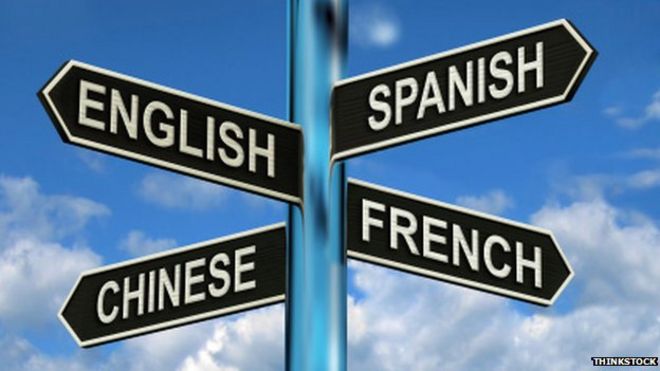English Is the Language of Science
That’s lousy luck for scientists in most of the world.

I learned English as a second language. Becoming an Anglophone turned out to be a crucial advantage in a brief scientific career years later. (I once worked as a medicinal chemist.) English is de rigueur for many things, but especially for science. More than three-quarters of scientific papers today are published in English—and in some fields it is more than 90 percent, according to data compiled by Scott Montgomery in his book Does Science Need a Global Language?.
As recently as the 1960s, some 40 percent of scientific literature was published in French, German, or Russian. Taxonomy has a Latin naming system, and astronomy is peppered with Arabic- and Persian-named stars—reminders of places where scientific prestige was once concentrated. As a student struggling with organic chemistry, I had the benefit of a German-speaking roommate to elucidate the mysterious nomenclature of so-called “e-” and “z-” molecular configurations: The estands for entgegen, meaning opposite; z is for zusammen, meaning together. The fact that the inventors of this naming convention—two Brits and a Swiss-Croatian—chose German to denote their rule in 1956 says something about the preeminence of the continental language in chemistry. “When I was young,” Alain-Jacques Valleron of the French Academy of Sciences told me, “all the good students would learn German.”
But no language has had as far a reach in science as English in the modern day. In part, this is thanks to victories in two world wars. As Michael Gordin, the author of a forthcoming book on scientific language, observed in a recent interview with PRI, “In 1915, Americans were teaching foreign languages and learning foreign languages about the same level as Europeans were.”* But by the 1920s, the zeitgeist was staunchly isolationist: German was criminalized in 23 states. De-emphasizing foreign language learning meant that a generation of American scientists grew up with little exposure to other languages. And scientists fleeing wars in Europe immigrated to the United States and started speaking English. Meanwhile, research activity in the United States surged. The National Science Foundation calculates that 293 Americans graduated with a research doctorate in 1902. By the 1990s, the country produced more than 30,000 new science Ph.D.s a year. More than a million new American researchers in the 20th century, almost all writing and publishing in English, have helped to make it the undisputable lingua franca.
Yet only 5 percent of people worldwide are native English speakers today, so thousands of scientists must now struggle to learn it. Students wrestle with mastering a new language as well as new subject material. “It is hard to get things right, to put down the right words,” Minxuan He, a graduate student in psychology at Berkeley, told me. “Often I will write down a sentence thinking it means exactly what I want to say, but then find out that the words don’t actually mean what I think,” she says. Her thoughts will be fluid and coherent when she conceives of them in her native Chinese. But they suddenly feel as if their logic is lost once translated into English. It is hard to convey original thought, because so much effort must first be put into learning how to translate every idea. Though many scientists can write fluently and with accuracy, Valleron says, they find themselves limited by more stammering spoken English. And it is “hard to express nuance,” whether in writing or in speech.
Perhaps this is an age-old struggle. Did founders of the Académie des Sciences, the ancestor of the French Academy of Sciences created under Louis XIV, excuse poor French from non-Francophone colleagues? Galileo is said to be the first European scientist to write in his native Italian. Was anything ever lost when translators rendered his papers into Latin? There are nods today to the need to judge works only by their scientific quality, not by how they are written. “When possible, reviewers and editors of manuscripts should look beyond errors in grammar, syntax, and usage, and evaluate the science,” urges a 2012 editorial in Molecular Biology of the Cell, an American journal.
Subtle things do get lost, now as they must have done in the past. Chinese scientists discussing the electrical conductivity of copper nanotubes in a 2007 Royal Society of Chemistry paper, for example, chose a rather unfortunate acronym for the subject of their study. (It rhymes with “runt.”) The acronym has stuck: A new study from this year in Science China, an English-language journal, uses the shorthand—innocuous to people who don’t know English slang and amusing for culturally immersed Anglophones, but hardly helpful for scientists wishing to be taken seriously.
English-speaking scientists should exhibit a bit more sympathy and patience toward their peers abroad. Most make little effort to learn another language, even if it is a requirement for foreign colleagues. Those who do know another language tend to revert back to English in casual discourse. “They do not want to do the painful job of trying to express an idea in a foreign language,” Valleron laments, as French, Chinese, or Russian scientists must do.











